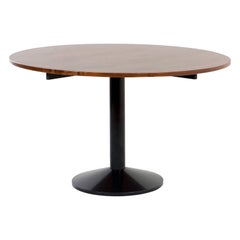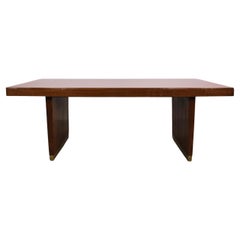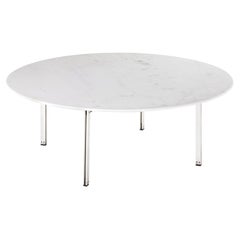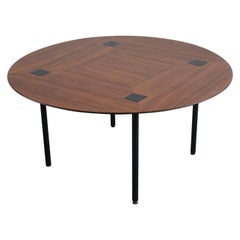Want more images or videos?
Request additional images or videos from the seller
1 of 9
Edoardo Paoli Set of Three Arlecchino Coffee Tables Glass and Metal 1950s Italy
$3,590.61List Price
About the Item
- Creator:Edoardo Paoli (Designer),Vitrex (Manufacturer)
- Dimensions:Height: 21.46 in (54.5 cm)Width: 21.26 in (54 cm)Depth: 18.9 in (48 cm)
- Style:Mid-Century Modern (Of the Period)
- Materials and Techniques:
- Place of Origin:
- Period:
- Date of Manufacture:1950s
- Condition:Wear consistent with age and use.
- Seller Location:Montecatini Terme, IT
- Reference Number:1stDibs: LU5304221658712
About the Seller
4.9
Vetted Professional Seller
Every seller passes strict standards for authenticity and reliability
1stDibs seller since 2020
127 sales on 1stDibs
Typical response time: 3 hours
Authenticity Guarantee
In the unlikely event there’s an issue with an item’s authenticity, contact us within 1 year for a full refund. DetailsMoney-Back Guarantee
If your item is not as described, is damaged in transit, or does not arrive, contact us within 7 days for a full refund. Details24-Hour Cancellation
You have a 24-hour grace period in which to reconsider your purchase, with no questions asked.Vetted Professional Sellers
Our world-class sellers must adhere to strict standards for service and quality, maintaining the integrity of our listings.Price-Match Guarantee
If you find that a seller listed the same item for a lower price elsewhere, we’ll match it.Trusted Global Delivery
Our best-in-class carrier network provides specialized shipping options worldwide, including custom delivery.You May Also Like
Edoardo Paoli Double Tier Arlecchino Table for Vitrex
By Vitrex, Edoardo Paoli
Located in Hanover, MA
Arlecchino double two-tier table designed by Edoardo Paoli for Vitrex circa 1955.
Original green enamel legs, If requested we can re-enamel in your choice of color(s).
Original amoeba form glass nearly half inch thick, both marked Vitrex, both with dimples.
Very clever design with a steel rod passing through an elongated tapered tube secured on each end by a brass domed screw cap and a brass conical foot with brass spacers in between.
Note we have vintage French etagere tables by Dekora Nantes...
Category
Vintage 1950s Italian Mid-Century Modern Coffee and Cocktail Tables
Materials
Brass, Steel
Italian "Arlecchino" side table by Edoardo Paoli for Vitrex, 1950s
By Vitrex, Edoardo Paoli
Located in Linkebeek, BE
Italian "Arlecchino" side table by Edoardo Paoli for Vitrex, 1950s
"Arlecchino" side table by Edoardo Paoli
Measures : 65cmx57cm H:55cm
Materials : Metal - Glass
Wear Consistent with...
Category
Mid-20th Century Italian Mid-Century Modern Side Tables
Materials
Metal
$1,615
H 21.66 in W 25.6 in D 22.45 in
1950s Edoardo Paoli 'Arlecchino' Two Tier Glass Side Table For Vitrex
By Edoardo Paoli, Vitrex
Located in London, GB
Edoardo Paoli: 'Arlecchino' Two-Tier Glass Side Table for Vitrex, c.1950s
Designed by Edoardo Paoli for Vitrex in the 1950s, the 'Arlecchino' side table is a striking example of mid...
Category
Vintage 1950s Italian Mid-Century Modern Side Tables
Materials
Metal
$2,558
H 29.53 in W 18.9 in D 21.66 in
Edoardo Paoli Mid Century Italian Side Table 'Arlecchino' for Vitrex, 1950s
By Edoardo Paoli, Vitrex
Located in Morazzone, Varese
Coffee table or sofa table in kidney shape, Model "Arlecchino" with multicolored painted metal legs in red, yellow, black and blue with brass details on two kidney-shaped tempered gl...
Category
Vintage 1950s Italian Mid-Century Modern Side Tables
Materials
Metal
$2,633
H 21.46 in W 43.31 in D 21.26 in
1950ies Two-Tiered Arlecchino Side Table Designed by Eduardo Paoli in 1955
By Vitrex, Edoardo Paoli
Located in Offenburg, Baden Wurthemberg
1950ies two-tiered Arlecchino side table designed by Eduardo Paoli in 1955.
Manufactured by Vitrex, Italy ca. in 1960.
Beautiful small side or coff...
Category
Vintage 1950s Italian Mid-Century Modern Side Tables
Materials
Metal, Brass
$1,914
H 21.26 in W 46.46 in D 19.69 in
Mid-Century Italian Coffee Table, C.1950s
Located in London, GB
Mid-century design Italian coffee table, circa 1950s, in wood, brass and painted metal.
Dimensions: H 50 x W 105 x W 61 cm.
Category
20th Century Italian Mid-Century Modern Coffee and Cocktail Tables
Materials
Wood
EDOARDO PAOLI - Produced by VIS - Coffe Table 1950s - Made in ITALY.
By Edoardo Paoli
Located in Milano, IT
Original 1950s TABLE designed by Edoardo Paoli and produced by the VIS - ITALY. creator of another coffee table model ARLECCHINO.
Of excellent quality and elegant design to match, ...
Category
Vintage 1950s Italian Mid-Century Modern Center Tables
Materials
Brass, Iron
$3,470
H 21.46 in W 27.56 in D 17.72 in
Large Brass and Glass Coffee Table, France, circa 1950s
Located in Isle Sur La Sorgue, Vaucluse
Low coffee table of striking design. The brass base (hollow, and surprisingly light) is made up of four interlocked rectangles, supported by four feet, so that the rectangles are com...
Category
Mid-20th Century French Mid-Century Modern Coffee and Cocktail Tables
Materials
Brass
Italian Sofa Table on Three Wooden Legs, 1950s
Located in Wolfurt, AT
This elegant sofa table was made in Italy in the 1950s. The round glass top is supported by three, beautifully worked beech wood legs. The three legs are connected by a round wooden ...
Category
Vintage 1950s Italian Mid-Century Modern Tables
Materials
Brass, Metal
Midcentury Coffee Table Made in Italy, 1950s
Located in taranto, IT
Original coffee table from the 60s with a beautiful Italian design, with double wooden shelf covered with formica wood effect and aluminum frame with curved legs
It measures 60 cm...
Category
Vintage 1950s Coffee and Cocktail Tables
Materials
Metal
More From This Seller
View AllFranco Albini TL30 Round Table in Metal and Wood by Poggi 1950s
By Poggi, Franco Albini
Located in Montecatini Terme, IT
TL30 table with a round top in wood and a base in black lacquered metal, designed by Franco Albini and produced by Poggi in the 1950s.
After spending his childhood and part of his youth in Robbiate in Brianza, where he was born in 1905, Franco Albini moved with his family to Milan. Here he enrolled in the Faculty of Architecture of the Polytechnic and graduated in 1929. He starts his professional activity in the studio of Gio Ponti and Emilio Lancia, with whom he collaborates for three years. He probably had his first international contacts here
In those three years, the works carried out are admittedly of a twentieth-century imprint. It was the meeting with Edoardo Persico that marked a clear turning point towards rationalism and the rapprochement with the group of editors of “Casabella”.
The new phase that that meeting provoked starts with the opening of the first professional studio in via Panizza with Renato Camus and Giancarlo Palanti. The group of architects began to deal with public housing by participating in the competition for the Baracca neighborhood in San Siro in 1932 and then creating the Ifacp neighborhoods: Fabio Filzi (1936/38), Gabriele D’Annunzio and Ettore Ponti (1939).
Also in those years Albini worked on his first villa Pestarini.
But it is above all in the context of the exhibitions that the Milanese master experiments his compromise between that “rigor and poetic fantasy” coining the elements that will be a recurring theme in all the declinations of his work – architecture, interiors, design pieces . The opening in 1933 of the new headquarters of the Triennale in Milan, in the Palazzo dell’Arte, becomes an important opportunity to express the strong innovative character of rationalist thought, a gym in which to freely experiment with new materials and new solutions, but above all a “method”.
Together with Giancarlo Palanti, Albini on the occasion of the V Triennale di Milano sets up the steel structure house, for which he also designs the ‘furniture. At the subsequent Triennale of 1936, marked by the untimely death of Persico, together with a group of young designers gathered by Pagano in the previous edition of 1933, Franco Albini takes care of the preparation of the exhibition of the house, in which the furniture of three types of accommodation. The staging of Stanza per un uomo, at that same Triennale, allows us to understand the acute and ironic approach that is part of Albini, as a man and as a designer: the theme addressed is that of the existenzminimum and the reference of the project is to the fascist myth of the athletic and sporty man, but it is also a way to reflect on low-cost housing, the reduction of surfaces to a minimum and respect for the way of living.
In that same year Albini and Romano designed the Ancient Italian Goldsmith’s Exhibition: vertical uprights, simple linear rods, design the space. A theme, that of the “flagpole”, which seems to be the center of the evolution of his production and creative process. The concept is reworked over time, with the technique of decomposition and recomposition typical of Albinian planning: in the setting up of the Scipio Exhibition and of contemporary drawings (1941) the tapered flagpoles, on which the paintings and display cases are hung, are supported by a grid of steel cables; in the Vanzetti stand (1942) they take on the V shape; in the Olivetti store in Paris (1956) the uprights in polished mahogany support the shelves for displaying typewriters and calculators. The reflection on this theme arises from the desire to interpret the architectural space, to read it through the use of a grid, to introduce the third dimension, the vertical one, while maintaining a sense of lightness and transparency.
The flagpole is found, however, also in areas other than the exhibition ones. In the apartments he designed, it is used as a pivot on which the paintings can be suspended and rotated to allow different points of view, but at the same time as an element capable of dividing spaces. The Veliero bookcase...
Category
Vintage 1950s Italian Mid-Century Modern Tables
Materials
Metal
Table in Oak Brass and Red Laminate Italian Manifacture 1950s Gio Ponti
By Gio Ponti
Located in Montecatini Terme, IT
Large table or desk with structure in oak wood, tabletop in red laminate and brass details.
Designe by Gio Ponti for Banca Nazionale del Lavoro, Italian manufacture from the 1950s.
...
Category
Vintage 1950s Italian Mid-Century Modern Tables
Materials
Brass
Florence Knoll Parallel Bar Round Table in Marble and Steel by Knoll 1950s
By Florence Knoll, Knoll
Located in Montecatini Terme, IT
Low table with a round-shaped table top in white marble and four metal legs from the Parallel Bar series, designed by Florence Knoll and manufactured by Knoll International during the 1950s.
Born to a baker, and orphaned at age twelve, Florence Schust grew up in Saginaw, Michigan. Schust demonstrated an early interest in architecture and was enrolled at the Kingswood School for Girls, adjacent to the Cranbrook Academy of Art.
While at Kingswood, Florence befriended Eilel Saarinen, whom she would later study under at Cranbrook. Warmly embraced by the Saarinen family, Florence vacationed with them in Finland, enjoyed the company of their accomplished friends, and formed a very close relationship with Eliel’s son, Eero. The connections she made and the skills she developed while at Cranbrook were the foundations of Florence Schust’s incredible design education and pioneering career. With recommendations from Eliel Saarinen and Alvar Aalto, Florence went on to study under some of the greatest 20th century architects, including Walter Gropius and Marcel Breuer in Cambridge, Massachusetts and Ludwig Mies van der Rohe at the Illinois Institute of Technology.
In 1941 Florence moved to New York where she met Hans Knoll who was establishing his furniture company. With Florence’s design skills and Hans’ business acumen and salesmanship, the pair, who married in 1946, grew the nascent company into an international arbiter of style and design. Florence also seeded contributions with her friends Eero Saarinen, Harry Bertoia, and Mies van der Rohe.
In creating the revolutionary Knoll Planning Unit, Florence Knoll defined the standard for the modern corporate interiors of post-war America. Drawing on her background in architecture, she introduced modern notions of efficiency, space planning, and comprehensive design to office planning. Florence ardently maintained that she did not merely decorate space. She created it. The Planning Unit rigorously researched and surveyed each client — assessing their needs, defining patterns of use and understanding company hierarchies — before presenting a comprehensive design, informed by the principles of modernism and beautifully executed in signature Knoll style. Florence and the Planning Unit were responsible for the interiors of some of America’s largest corporations, including IBM, GM and CBS.
As part of her work with the Planning Unit, Florence frequently contributed furniture designs to the Knoll catalog...
Category
Vintage 1950s Italian Mid-Century Modern Center Tables
Materials
Marble, Metal, Steel
Ettore Sottsass T72 Round Table in Wood and Brass by Poltronova 1950s
By Ettore Sottsass, Poltronova
Located in Montecatini Terme, IT
Round table model T72 in wood, black lacquered metal and brass details, designed by Ettore Sottsass and produced by Poltronova in the late 1950s.
The T72 table has a strong base mad...
Category
Vintage 1950s Italian Mid-Century Modern Dining Room Tables
Materials
Metal, Brass
Lorenzo Burchiellaro Cart with Wheels in Metal and Glass Italian Manufacture 70s
By Lorenzo Burchiellaro
Located in Montecatini Terme, IT
Cubic-shaped cart with wheels with frame realized in metal which present a circular void on each side, the top and the bottom of the cart has realized in glass.
The cart was design...
Category
Vintage 1970s Italian Post-Modern Carts and Bar Carts
Materials
Metal
Ettore Sottsass Rectangular Wooden Coffee Table by Poltronova 1960s Italy
By Poltronova, Ettore Sottsass
Located in Montecatini Terme, IT
A rectangular low coffee table entirely made in wood, designed by Ettore Sottsass for Poltronova, Agliana 1960s.
The son of an architect, Ettore Sottsass Jr. (1917-2007) was born i...
Category
Vintage 1960s Italian Mid-Century Modern Coffee and Cocktail Tables
Materials
Wood
Recently Viewed
View AllMore Ways To Browse
Three Leg Coffee Table
Paoli Edoardo
Arlecchino Table
Cocktail Table By Philip And Kelvin Laverne
Composite Table
Drexel Mid Century Coffee Table
Elm Tree
Fossil Coffee Table
Gear Coffee Table
Japanese Hand Carved Coffee Table
Milo Baughman Burlwood
Noom Coffee Table
Paul Evans Copper
Postmodern Tessellated Stone
Sliding Top Table
Smoke Mirror Table
Vintage Butterfly Top
Vintage Yellow Tiles



